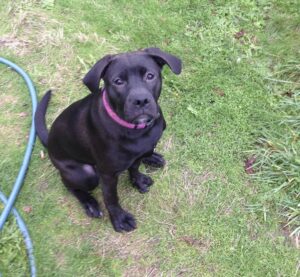
One of the most popular topics during your puppy’s first visit with us is potty training. The whole process can definitely seem intimidating and make us nervous to think about! Luckily, it doesn’t have to be extremely difficult and is actually very simple. We would like to provide you with some tips that can help you and your puppy establish a successful routine together.
The good news is you have Mother Nature working with you from the start. When puppies are first born, they eat and relieve themselves inside the den and mama dog is there to clean them up. There is never a scent of urine or feces where the puppies eat, sleep, and live. When they get old enough, they learn to use outside areas and imitate their mother’s habits. This way, all dogs become conditioned to never potty where they eat and sleep. From two to four months, most puppies can pick up on the concept of potty training quite easily since it is part of their natural programming.
The first key to success is following a schedule. Keep in mind that puppies may need to urinate every 30 to 60 minutes when they are very young. Their digestive tract is extremely quick and efficient which helps us to know when they will need to go. Five to 30 minutes after puppy eats, it will be time to poop! With a consistent eating schedule, and your adherence to a potty schedule, your puppy can maintain regular trips outside and learn to depend on them.
In the early days of training, you want to make sure the puppy has a place to go potty where they feel safe; a place that looks and smells familiar. Have you noticed that dogs will go potty in the same spot they’ve done so before? The scent acts as a trigger to them. Using training pads are acceptable too but are sometimes hard to train out of when the dog is an adult. Some dogs will confuse the potty pads with household rugs in the future and do not learn that elimination is only to happen outside.
Always remember that your own energy is a big factor in your potty training efforts. If you are feeling nervous or impatient or are trying to rush your puppy, that can also stress them out. Using a loud, high tone to encourage your puppy to “go potty” can be a distraction, so try and avoid any conversation at all until they are done.
Throughout the day, bring your puppy outside to the same area. It is important to remain consistent when it comes to “when and where” so your puppy can learn the habit.
Once your puppy has successfully gone outside, it is important to reward the good behavior. A simple quiet approval or a yummy treat can get the message across of a job well done.
What if an accident happens in the house? These are bound to happen in the early days. Stay patient and don’t punish your puppy for an accident. We don’t want anything to create a negative association with bodily functions. Stay calm and assertive and quietly remove the puppy to the place where you want him to go. If they go again outside for you, don’t forget to have a treat ready for positive reinforcement!
When done correctly, potty training should only be a matter of putting a little extra work into getting your puppy on a schedule during those first weeks at home. Don’t let unnecessary stress get in the way of the joy surrounding the puppy training process and your new best friend’s puppyhood.
Example of a puppy schedule:
7 AM to 8 AM
Wake up
Morning walk
Potty trip
Breakfast
Play time
8 AM to 10 AM
Playtime
Potty trip (5-30 minutes after breakfast)
10 AM to 1 PM
Nap time (Puppies can sleep approximately 14-18 hours a day!)
12 PM to 1 PM
Potty trip
Lunch (treats or meal)
Let pup follow you around as you go about your day
1 PM to 5 PM
More napping or play
5 PM to 6 PM
Potty trip
Afternoon walk
Play time
6 PM to 7 PM
Dinner
Potty trip
Bonding/play
7PM to 11 PM
Wind down time..
Quiet play
Last potty trip before bed….
A good reference on how often your puppy will need to go potty is by using his age in months as a guide. If puppy is 3 months old, he needs a potty break every 3 hours. If you work long hours, especially over 8 hours a day, it may be best to invest in a dog walker, dog sitter, or doggie daycare facility to help you make sure that your puppy is being offered the appropriate amount of potty breaks for their age.
If you want to train your puppy on potty pads, follow the same instructions above. Take your puppy to the pad during the scheduled potty time and reward them when they’ve used it. Keep the pad in the same area and take them back to it each time or immediately following an accident. If the potty pad is left with them during the day, make sure it is in a designated area that is not near their bed, food or water bowls, or they will likely refuse to use it!
Happy Potty Training!

